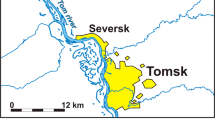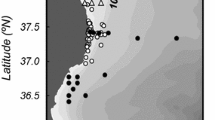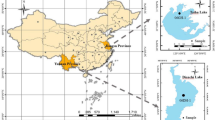Abstract
The 5–17-year migration of 137Cs in bottom sediments (BSs) of five oligotrophic lakes located on the “Chernobyl” 137Cs fallout plume was studied. The layer-by-layer analysis of the 137Cs levels in BS cores allowed determination of the 137Cs migration mechanism and of the numerical characteristics of its transfer into the thickness of BSs of low-trophy water bodies. The exponential decrease in the 137Cs concentration from the core surface to the BS depth was evaluated by the half-loss layer h. The value of h for “Chernobyl” 137Cs for BSs of oligotropic lakes was 1.2–2.3 cm. The 137Cs transfer in BSs of oligotrophic lakes occurred by the diffusion mechanism. The diffusion coefficients (D) of “Chernobyl” 137Cs in the lake BS columns were (2.0–4.7) × 10−8 cm2 s−1. The diffusion coefficients in 137Cs migration increased from the near-surface layer of bottom sediments (∼0–2 cm) to the depth of the bottom soil in the range n × (10−9–10−8) cm2 s−1. The numerical characteristics of the 137Cs migration (h and D) refer to BSs of oligotrophic lakes in which the flow of sediments to the lake bottom did not exceed 1.8 mm year−1. In Lake Sukhodol’skoe at a sedimentation rate of 6 mm year−1 and radionuclide exposure of 31 years, the bulk of BSs was contaminated with 137Cs by the mixed mechanism: diffusion from the primary accumulation site and sedimentation of suspended matter with 137Cs.
Similar content being viewed by others
References
Margulis, U.Ya., Atomnaya energiya i radiatsionnaya bezopasnost’ (Atomic Energy and Radiation Safety), Moscow: Energoatomizdat, 1983.
Mahura, A., Baklanov, A., Rigina, O.Y., et al., in 5th Int. Conf. on Environmental Radioactivity in the Arctic and Antarctic, St. Petersburg, 2002, pp. 119–123.
Bakunov, N.A., Savatyugin, L.M., and Frolov, I.E., Arktika: Ekol. Ekon., 2011, no. 1, pp. 82–93.
Saxen, R. and Koskelainen, U., Radioactivity of surface water and freshwater fish in Finland in 1988–1990, Suppl. 6 to Annual Report STUK-A94.
AMAP Assessment 2009: Radioactivity in the Arctic, Oslo, 2010, pp. 35–38.
Ilus, E. and Saxen, R., J. Environ. Radioact., 2005, vol. 82, pp. 199–221.
Brittain, J.E. and Borgstrom, R., Hydrobiologia, 2010, vol. 642, pp. 5–15.
Wathne, B.M., Patrick, S.T., Monteith, D., and Barth, H., Acidification of mountain lakes: palaeolimnology and ecology (AL:PE 1 report), Eur. Commission Report EUR 16129 EN, 1995.
Saxen, R. and Ilus, E., Sci. Total Environ., 2008, vol. 394, pp. 349–360.
Bol’shiyanov, D.Yu., Bakunov, N.A., and Makarov, A.S., Lithol. Miner. Resources, 2014, vol. 49, no. 2, pp. 177–183.
Bakunov, N.A., Bol’shiyanov, D.Yu., and Makarov, A.S., Radiochemistry, 2017, vol. 59, no. 5, pp. 540–546.
Bakunov, N.A., Bol’shiyanov, D.Yu., and Makarov, A.S., Water Resources, 2012, vol. 39, no. 5, pp. 556–563.
Gritchenko, Z.G., Ivanova, L.M., Tishkov, V.P., and Tsvetkov, O.S., Radiochemistry, 2001, vol. 43, no. 3, pp. 315–319.
Safronova, N.G., Pitkyanen, G.B., and Pogodin, R.I., in Problemy radioekologii vodoemov-okhladitelei atomnykh elektrostantsii (Radioecological Problems of Cooling Ponds of Nuclear Power Plants), Sverdlovsk: Ural’skoe Otdel. Akad. Nauk SSSR, 1978, pp. 95–98.
Prokhorov, V.M., Migratsiya radioaktivnykh zagryaznenii v pochvakh. Fiziko-khimicheskie mekhanizmy i ikh modelirovanie (Migration of Radioactive Contaminants in Soils. Physicochemical Mechanisms and Their Modeling), Moscow: Energoizdat, 1981.
Polyakov, Yu.A., Radioekologiya i dezaktivatsiya pochv (Radioecology and Soil Decontamination), Moscow: Atomizdat, 1970.
Semenovich, N.I., Donnye otlozheniya Ladozhskogo ozera (Bottom Sediments of Lake Ladoga), Moscow: Nauka, 1966.
Sukhoruchkin, A.K., Meteorol. Gidrol., 1985, no. 7, pp. 76–81.
Author information
Authors and Affiliations
Corresponding author
Rights and permissions
About this article
Cite this article
Bakunov, N.A., Bol’shiyanov, D.Y. & Pravkin, S.A. 137Cs in Bottom Sediments of Oligotrophic Lakes: Migration Mechanism. Radiochemistry 61, 122–128 (2019). https://doi.org/10.1134/S1066362219010181
Received:
Revised:
Accepted:
Published:
Issue Date:
DOI: https://doi.org/10.1134/S1066362219010181




